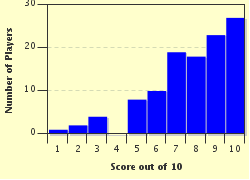Quiz Answer Key and Fun Facts
1. Lydia Liliʻu Loloku Walania Wewehi Kamakaʻeha was born in 1838. In 1891 she inherited the throne of her native land from her brother, King Kalahaua, and ruled with the royal name of Liliʻuokalani. On January 17, 1893, she was deposed by European and American businessmen, and her kingdom, which had been independent since 1810, was annexed by the United States. What is the name of that former kingdom?
2. A former Governor of Tennessee and Speaker of the House of Representatives, this Democratic candidate for President in 1844 favored the annexation of Oregon and Texas in his campaign. Who was he?
3. He built America's largest newspaper chain and, as a purveyor of yellow journalism, publicized Cuba's struggle for independence against Spain and helped push the United States into the Spanish-American War with his cartoons, headlines, and drawings. Who was this tycoon, who told his illustrator, Frederic Remington, whom he sent to Cuba, "You furnish the pictures, and I'll furnish the war."?
4. Although people often believe the Monroe Doctrine was anti-imperialistic, it was actually intended to give the United States more power over the rest of the Western Hemisphere. Who was Monroe's Secretary of State (and future President) who actually penned the document?
5. Who was the Secretary of State under Abraham Lincoln who purchased Alaska from Russia?
6. The last bit of the contiguous 48 states was added in 1853. It was the area south of the Gila River and west of the Rio Grande in the current states of Arizona and New Mexico. Who was the American ambassador to Mexico who made the purchase, which was signed by President Franklin Pierce and finalized in 1854?
7. As Vice President he was strongly opposed to a powerful central government, favoring instead a confederation with power in the hands of the states. However, as President, he doubled the size of the United States with a few strokes of his pen. Who was he?
8. Ten days after the USS Maine was destroyed in Havana Harbor in 1898, the Assistant Secretary of the Navy took the bull by the horns, and in the absence of the Secretary, ordered George Dewey to sail to the Philippines, thus resulting in the defeat of the Spanish fleet there, and the eventual acquisition of the islands for the U.S. Who was this former Police Commissioner of New York City and Dakota cowboy, and future Vice President?
9. One of the major influences upon American imperialists as a whole and Theodore Roosevelt in particular, was a U.S. naval officer who published a book in 1890 called "The Influence of Sea Power upon History." Who was he?
10. Not all Americans totally embraced imperialism. One was a renowned writer, who had initially strongly favored "the American eagle ... screaming into the Pacific." But with the Spanish-American War he changed his mind, decrying the military aspect of imperialism in a short book called "The War Prayer," in which he wrote in part, "For our sakes who adore Thee, Lord, blast their hopes, blight their lives, ... stain the white snow with the blood of their wounded feet!" Who was this literary icon?
Source: Author
shvdotr
This quiz was reviewed by FunTrivia editor
bloomsby before going online.
Any errors found in FunTrivia content are routinely corrected through our feedback system.

